There are over 50 species of ‘day gecko’ belonging to the Phelsuma genus. They are brightly coloured lizards from the Gekkonidae family and are found across Madagascar and the neighbouring islands (Mauritius, Seychelles, Reunion, etc). Most Phelsuma species are neon green with vivid blue and red patterns. As their name suggests, they are diurnal, highly active lizards. These characteristics make day geckos some of the most entertaining of all pet lizards and have prompted hobbyists to keep and breed a variety of species since the 1980s.
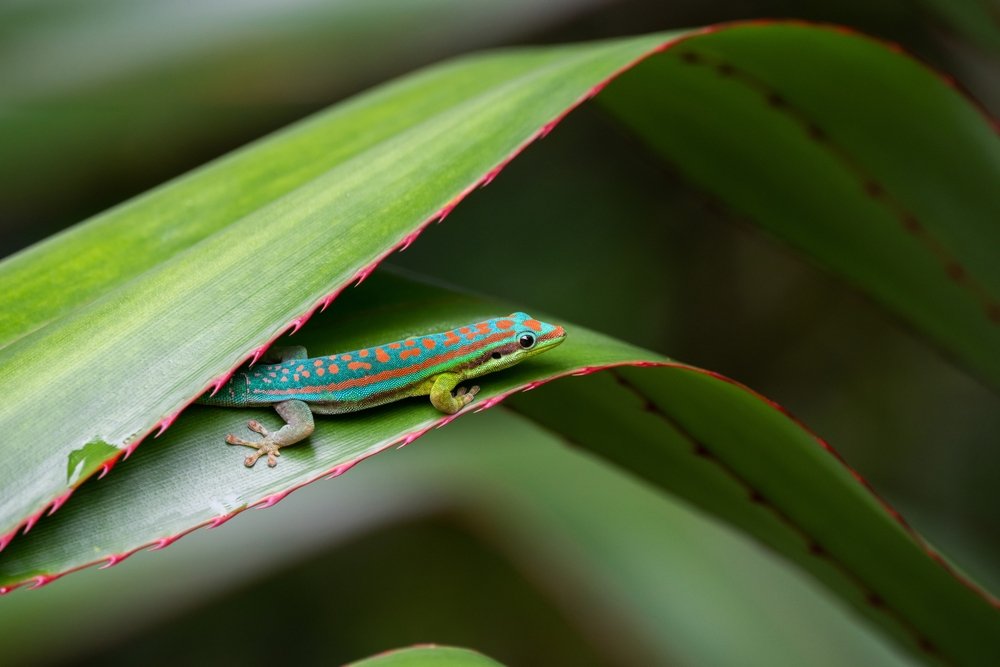

Phelsuma Diversity
There is a lot of diversity within the Phelsuma genus. The largest of the species, P. grandis or the ‘giant day gecko’ can grow over a foot long, whereas the smallest, P. klemmeri rarely exceeds 10cm. Of the 53 species described at the time of writing, seven were newly discovered in the last 20 years (and even more subspecies have been named more recently). Many of these species are sexually dimorphic. Males typically growing larger than females and have distinct preano-femoral pores. They are usually vibrant lizards but will quickly change their colouration to become drabber if they are stressed. Although some day geckos are very adaptable and some thrive in human-inhabited areas, deforestation in Madagascar threatens many Phelsuma species. This is even more disastrous to island populations and has directly caused the functional extinction of several species within the last decade.
Not only do these lizards rely on delicate ecosystems, but in many cases, the ecosystem also relies on them. Day geckos are active seed dispersers and pollinators. They will feed heavily on fruits and nectar and patrol reasonably large territories spreading these seeds across forests and built-up areas. Their ability to adapt to human infrastructure has brought many benefits from spreading wildflowers to controlling mosquitos and other biting insects.
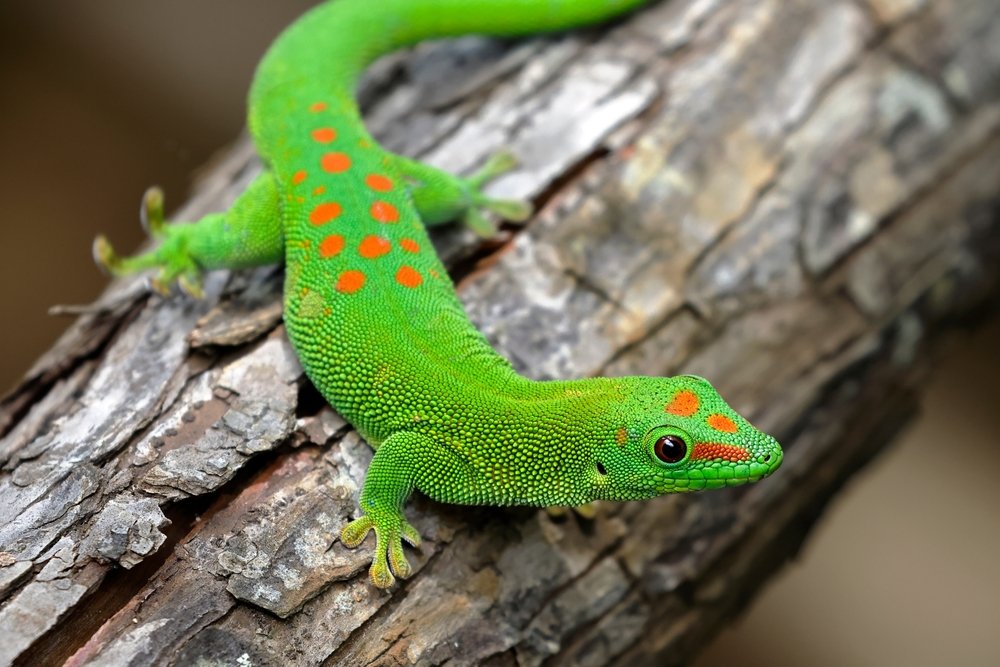
Phelsuma Farm
Simon Prentice is a UK-based day gecko breeder in Somerset. He took on and developed Phelsuma Farm in 2015 from Toby Mace who had established the breeding project in 1988. In 2019, Simon opened Phelsuma Farm to the public for the first time, allowing visitors to view his Phelsuma breeding centre and collection. Simon told Exotics Keeper Magazine: “In the late ‘80’s and early ‘90’s, lineata, laticauda and grandis were commonly imported and wild-caught specimens would frequently show up at wholesalers and shops. This was with good reason – these species are the most abundant, widespread and adaptable of the Phelsuma. Fortunately, in one respect, this is no longer the case – Madagascan export restrictions mean that stressed, parasite-laden wild animals are now rarely available. Now, I’m mostly focussing on high quality Phelsuma grandis, Phelsuma cepediana, Phelsuma laticauda, Phelsuma klemmeri and a few other species.”


Day Care
Day geckos are extremely fragile lizards and certainly not an ideal ‘pet’. Even the largest species are basically un-handleable. Like most lizards, day geckos will drop their tails if they are injured or restrained. Some species of day geckos take this one step further. Their soft and delicate skin can easily tear and in the case of P. grandis (and possibly several other species) chunks of skin can be removed completely to help them evade predators. This means that extra consideration must be made to protect Phelsuma from unnecessary trauma. Keepers have reported anything from territorial disputes to aggressive feeder insects causing medically significant damage to their geckos. Despite this, their care requirements are reasonably straightforward and provided they are treated solely as an ‘observation’ lizard, almost all readily available Phelsuma species are easily maintained. They also make excellent observation animals and for those wishing to build a naturally planted slice of the Malagasy rainforest, day geckos are the perfect pet. Most day geckos have been recorded to live up to 20 years, with some of the larger species living even longer.
The first decision that a keeper is likely to make when selecting a day gecko species, is the size of the enclosure that they can provide. A trio of small neon day geckos (P. klemmeri) will happily live in a 30x30x60 terrarium. A giant day gecko, however, should ideally be housed in at least a 60 x 45 x 60cm glass terrarium. Whilst these dimensions are logically based on the size of the animals, the smallest species often receive the largest enclosures based purely on their unproblematic cohabitation potential. Often, keepers will house klemmeri with poison frogs in very large bioactive setups. Whilst a bit of maintenance is required, these communities tend to live amicably. Larger-bodied lizards such as grandis are generally more territorial, far more destructive and will make more of a mess down the glass surfaces so, are often kept in smaller easier-to-manage enclosures. Neither species are appropriate to handle and therefore, it is important that the keeper seriously considers which species is right for them.
Regardless of the size of the gecko, broad-leaved plants are required to give them places to hide. Smaller geckos will benefit from thick-stemmed plants such as peace lilies (Spathiphylum), Sansevieria, and spider plants (Chlorophytum), as they can hide amongst the leaves. Broad-leaved plants such as Monstera, Epipremnum and Calathea will also provide valuable basking spots for larger species and create visual barriers for smaller co-habiting species. Another useful piece of décor is bamboo. Some species have been recorded only on dead or decaying bamboo. Whether this is because it may attract more insects, or because the darker colouration provides more heat, or simply that it’s easier to navigate remains a mystery. However, bamboo plays a fundamental role in the lives of smaller species such as klemmeri. It is extremely practical in a vivarium setting and can provide shelter for smaller species as well as provide basking platforms for all arboreal geckos. Clever positioning of vertical bamboo branches will allow the geckos to utilise possibly the most important aspect of their enclosure, zonal lighting.
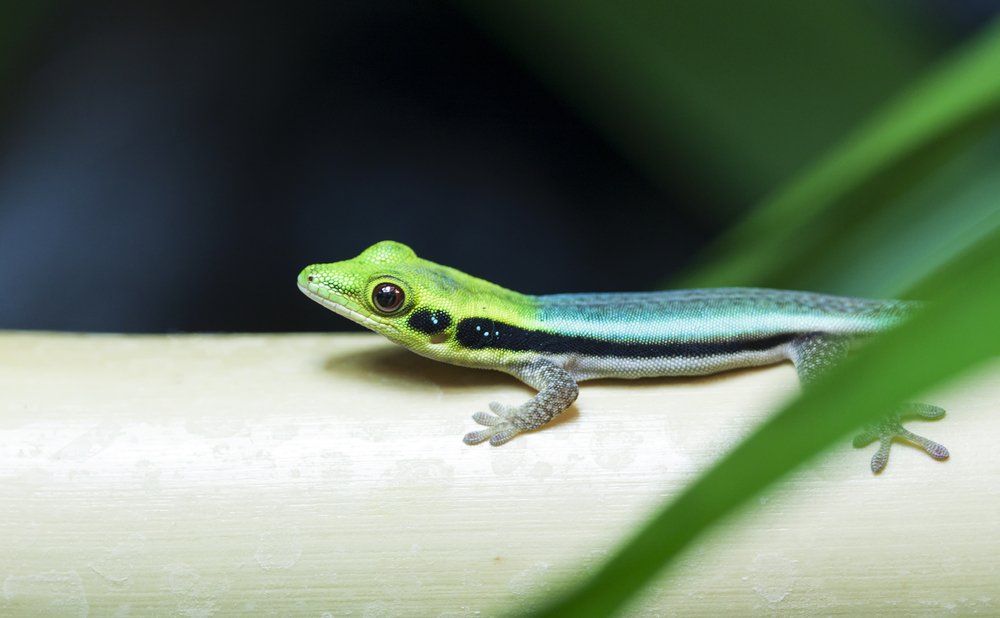

Zonal Lighting
Daygeckos, unsurprisingly, need good-quality, full spectrum lighting that replicates the sun. Like all heliotherms, they require external sources to regulate their body temperature and having full control over when to warm up or cool down is a requirement for a lizard to stay healthy. In tropical, arboreal setups a ‘zonal lighting’ model is best applied. By adding overlapping, vertical bamboo poles from the top of the enclosure to the bottom, the gecko can pick and choose just how close they want to be to the light, without grasping onto the mesh. This should allow their entire body to receive the necessary UV and IR in short bursts as they require it, then move to a lower branch to remain warm without such high radiation exposure. The use of a metal halide with a strong reflector will produce a powerful beam of light and heat which the animal can move closer to and further away from. This method of lighting will penetrate deep into the enclosure, preventing the animals from clustering around a preferred basking spot which can lead to aggression and stress. It is important to remember metal halides cannot be used with a thermostat, which means that they are not suited to small enclosures. Smaller enclosures require high output T5 UVB light and a basking spot lamp controlled by a dimming thermostat. A high output T5 can also be a great investment for keepers who are looking to light several smaller vivariums.
Where possible, the keeper should provide seasonality in their lighting. “Gradually changing the daylight cycle for a couple of months will halt mating and give breeding females a chance to rest and recuperate” explains Simon. “A couple of degrees ambient temperature drop during the rest season, followed by a return to the slightly warmer ambient temperature should trigger mating behaviours as a new season starts.” New technologies in herpetoculture can be of serious benefit to day gecko keepers. Not only do they provide more accurate environmental conditions, but they can also give the keeper far more freedom. Simon continued: “Keepers must use the very best UVB light units and full spectrum LED lights for their setups. I would also recommend people move towards smart technologies. Day geckos require excellent photoperiods, so a wifi thermostat such as a Microclimate Evo Connected will make things much easier for the keeper. Breeders should also consider setting up motion detection sensors in their incubators with notifications on phone apps. This is useful and gives the keeper up-to-date information as well as reducing the risk of an escapee.”
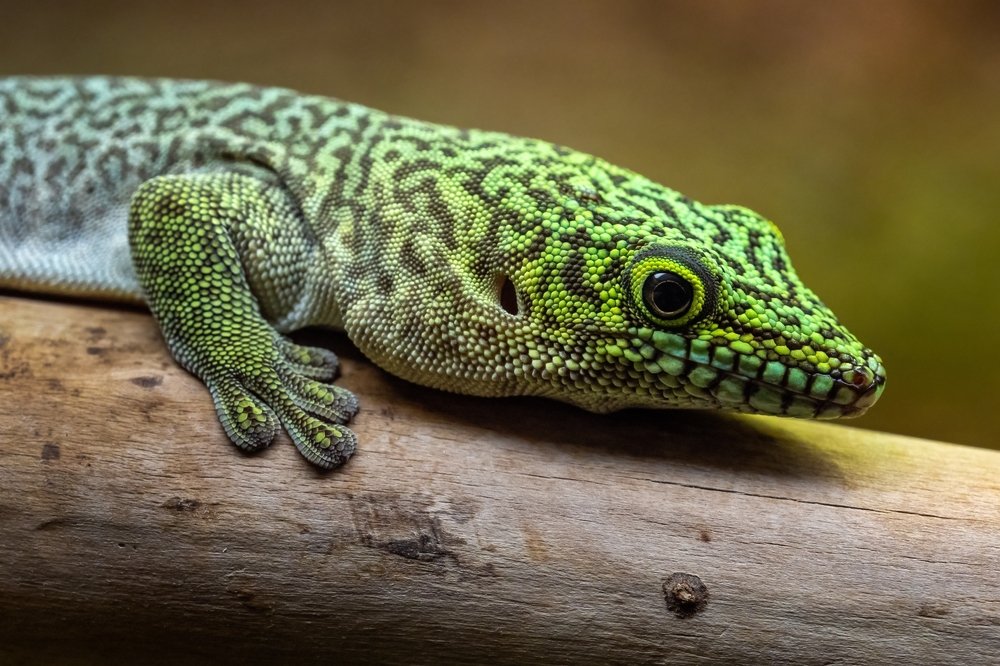

In Case of Escape
Day geckos are fast-moving, fragile animals that can scale just about any surface. An escapee is a serious cause for concern. The keeper should always locate the position of the animal before opening the door to the enclosure. The keeper should place their hands in front of the glass once the animal is located, to discourage it from accelerating forwards (which can certainly take people by surprise). However, it is not always that simple. Having kept and maintained hundreds of geckos in his time, Simon is no stranger to the odd escapee. He advises: “First, stay calm. This happens to the very best day gecko keepers. Smooth body movements will have a calming effect and the keeper should avoid sudden movements or noises. It is best to move only your eyes to scan for the lizard. Next, get someone else to keep an eye on the gecko while you reach for a long bamboo cane and an empty cricket tub. Close any open windows and doors. Once the room is secure, try to use the thin bamboo cane to coax the gecko to an open area of the wall and away from any nooks and crannies. Quietly, smoothly and confidently place the tub over the gecko taking care not to catch the gecko’s tail. If this does happen and the gecko drops part of its tail don’t panic as this will cause further stress to the animal. Finally, carefully slide the cricket tub lid under the tub, so the gecko is safely captured and ready to be returned to its enclosure.”
“The longer the chase continues, the greater the stress to the animal. You will need to learn when to leave it be and when to try later. Day geckos can learn the best hiding spots in the room and the longer it is left, the more confident and cunning the animal will become. If the recapture process lasts longer than a day, it is important to make sure there is a water source and food available and all doors and windows are kept closed.”
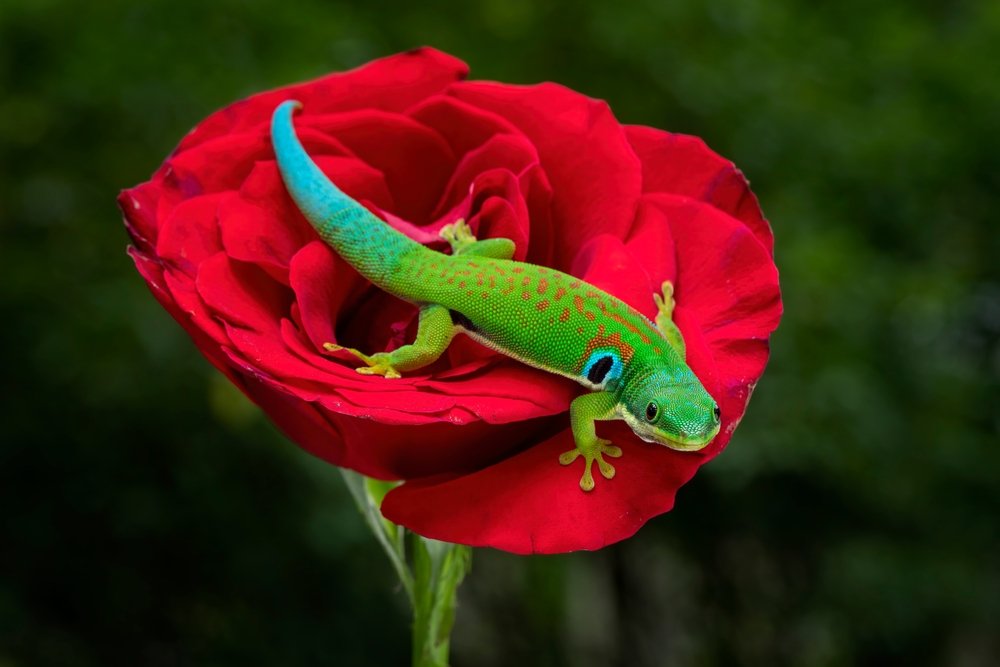
Breeding Day Geckos
Although some species of day geckos have been popular in captivity for many years, some obstacles make captive-breeding a challenging prospect. This has impacted and pre-determined the availability of many species in captivity. “The species from mainland Madagascar tend to be easier to work with as a breeder as they tend to be egg-layers” explains Simon. “Species such as giant day geckos (P. grandis), gold dust day geckos (P. laticauda), neon day geckos (P. klemmeri) and the lined day gecko (P. lineata) are all very popular for this reason. The more obscure species from the islands in the Indian Ocean such as the Mauritian blue-tailed day gecko (P. cepediana) and the Mauritian lowland forest day gecko (P. guimbeaui) are often egg-gluers.”
Egg-glueing species produce eggs that can stick firmly to different surfaces and are very hard to dislodge. It is impossible to guarantee exactly where the eggs will be laid, meaning some eggs will never make it into the incubator and leave the hatchlings vulnerable to other hungry geckos. Egg layers, on the other hand, support their eggs until the exterior shell hardens up. Not only are egg-layers easier to work with, but if the breeder can transfer the eggs into an incubator, they can determine the sex of the offspring. Naturally, this allows them to fulfil demand and support their own breeding collections with more success.
Simon continued: “Those who are breeding egg-glueing species should always provide removable egg-laying items (such as floral tubes) that can be moved into an incubator. Some breeders will glue some mesh around the egg-laying sites to protect hatchlings from the parents. Some people will leave the eggs to hatch in-situ and simply catch the babies before their parents devour them.”
The challenges presented by breeding large numbers of day geckos, when compared to other popular gecko species can be seriously off-putting for most hobbyists. At Phelsuma Farm, there are many other issues presented by breeding obscure and unique day gecko species. “Buyers always quite rightly want to see photos of the geckos they are buying” added Simon. “Try catching a good clear picture of a Phelsuma ornata or a Phelsuma cepediana, without the photo being blurred or the gecko escaping. It’s not easy. This makes the whole process of buying and selling day geckos a little more difficult than some other more easily handled and photographed species.”
“These things being said, the complexities and difficulties of breeding some of the more exotic Phelsuma day geckos are far outweighed by the experience of catching a glimpse of a Phelsuma borbonica, Phelsuma ornata, Phelsuma guimbeaui, Phelsuma inexpectata, or a Phelsuma robertmertensi. These to me are some of the most stunningly beautiful geckos on the planet.”